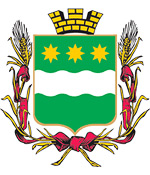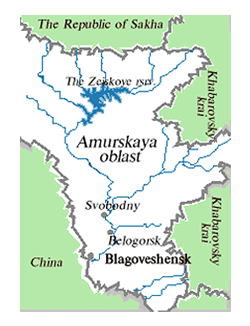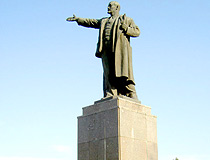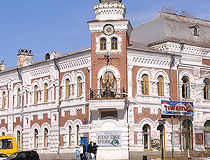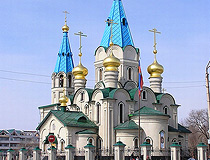Blagoveshchensk - Overview
Blagoveshchensk, a city located about 7,850 kilometers east of Moscow, is the capital of Amur Oblast, the fifth largest city in the Russian Far East. The city stands on the left bank of the Amur River, on the border of Russia with China, directly opposite the Chinese city of Heihe.
According to the Federal State Statistics Service of Russia, the population of Blagoveshchensk is about 245,200 (2025), the area - 321 sq. km.
The phone code - +7 4162, the postal codes - 675000-675029.
History of Blagoveshchensk
Foundation of Blagoveshchensk
The first Russian explorers appeared at the confluence of the Amur and Zeya rivers in the summer of 1644, when the pioneer Vasily Danilovich Poyarkov and his detachment stayed at this place. In 1653, the explorer Erofei Pavlovich Khabarov decided to build a fortified settlement on this site. But after the signing of the Treaty of Nerchinsk of 1689 (the first treaty between Russia and China under Qing dynasty), the Russians had to leave the left bank of the Amur River.
Subsequently, Russia made repeated attempts to revise the terms of this treaty. But until the middle of the 19th century, China refused to do it. In connection with the Crimean War, which began in 1853, there was a threat of an invasion of English-French troops in the Far Eastern territories of the Russian Empire. Nikolay Nikolayevich Muravyov, the Governor-General of Eastern Siberia, was given the authority to begin the transfer of troops from Transbaikalia to the lower reaches of the Amur.
In 1856, Muravyov got permission to found the Cossack outposts on the left bank of the Amur. In order to confirm Russia’s rights to this region, it was planned to establish several Cossack outposts on the left bank of the Amur, including the outpost of Ust-Zeysky (literally meaning “at the mouth of the Zeya River”). It became the beginning of the active Russian development of the Far East.
More historical facts…
In the summer of 1856, a military detachment of about 500 soldiers arrived on the left bank of the Amur River near the mouth of the Zeya River. The first group of settlers consisted of 60 Transbaikal Cossacks. In 1858, a church in honor of the Annunciation of the Blessed Virgin Mary was founded in the settlement of Ust-Zeysky and the settlement itself was renamed Blagoveshchenskaya (meaning “Annunciation settlement”).
After that, negotiations began between representatives of Russia and China. As a result, the Treaty of Aigun was signed, according to which the entire left bank of the Amur River was recognized as possession of the Russian Empire. On July 5, 1858, the town of Blagoveshchensk (“Annunciation town”) was established.
On December 8, 1858, the Amur Region was founded and Blagoveshchensk became its administrative center and an outpost of Russia on the banks of the Amur River, protecting the Far Eastern borders of the country.
Blagoveshchensk before the Soviet period
In 1860, the population of Blagoveshchensk was about 1,800 people. In 1865, private gold mining was allowed in the Amur Region. Thanks to this, the further development of Blagoveshchensk up to the Soviet period was closely linked to gold mining. Water transport developed at an accelerated pace - people could reach remote gold mines only by water. Agriculture also developed successfully.
In 1888, the first iron foundry in the Amur region began to operate in the town. It had a developed woodworking industry as well. By the end of the 19th century, Blagoveshchensk was a large river port and industrial center. In 1905, there were 157 steamboats and 220 barges here.
Anton Chekhov, one of the greatest writers of short fiction in history, who visited Blagoveshchensk in 1890, wrote the following: “…an extremely interesting region, life here is in full swing and Europe has no idea about it.” In 1891, this town was visited by Prince Nikolai, the future Russian Emperor Nicholas II. In memory of this event, the Arc de Triomphe was built. The population of the town was about 20,000 people.
In the summer of 1900, a conflict with the Chinese occurred in Blagoveshchensk during the Boxer Rebellion (Yihetuan Movement). July 1, 1900, China began military operations against Russia - the Chinese attacked Russian ships on the Amur River. In Blagoveshchensk, Russian residents hurriedly armed themselves, preparing to repel an attack from the Chinese side and possible hostile actions from ethnic Chinese living in the town and the Amur region.
A massive shelling of the town began from the other bank of the Amur and lasted two weeks. In Blagoveshchensk, cases of violence against the Chinese including murders became more frequent. The military governor of the police announced the decision to expel the Chinese from the town. In the narrowest place of the Amur River (upstream of Blagoveshchensk), at low water, it was planned to transport them to the other bank. But the misunderstanding of the decree and mutual bitterness led to the fact that the convoy Cossacks drove the Chinese to swim across the Amur. A lot of them did not know how to swim and died during the crossing, were shot.
The first train from Blagoveshchensk to St. Petersburg departed in December 1913. The population of the city reached 70,000 people.
Blagoveshchensk in the 20th century and beyond
In the 1920s, trade was developed in Blagoveshchensk in accordance with all the laws of the border town - including legal trade, as well as smuggling. From the Chinese side, the town received mainly alcohol, which was exchanged for gold.
Since 1937, the situation deteriorated significantly. First of all, because of the implemented collectivization of agriculture, and also because of the deprivation of the region’s gold mining base. However, it was in the 1930s that the Amur Metalworker plant was built in the city, as well as a sewing and confectionery factories. In 1939, the population of Blagoveshchensk was about 59,000 people.
In the 1930s, the military situation on the other bank of the Amur escalated. In 1932, the Japanese gained control of Manchuria. In August 1945, the Soviet army crossed the Amur River in the area of Blagoveshchensk in order to defeat the Japanese army in Manchuria. There is a monument (an armored boat) reminding of this event on the embankment of the city.
In 1948, Amur Oblast became a separate region of Russia. Blagoveshchensk began to develop as the administrative, economic, and cultural center of the region. In 1962, the population of the city exceeded 100 thousand people.
Until the end of the 1980s, entry for residents of other regions of the USSR into Blagoveshchensk was restricted; entry of foreigners was forbidden as it was a strategically important border city. In 1989, the population of Blagoveshchensk was about 205,000 people.
In 2003-2005, the Arc de Triomphe, destroyed in 1936, was rebuilt. In 2019, a road bridge connecting the city with Heihe (China) was completed southeast of Blagoveshchensk.
Today, Blagoveshchensk, one of the oldest merchant cities in the Far East, acts as an intermediary in the commercial and industrial relations of Siberia and the Russian Far East with China.
Pictures of Blagoveshchensk
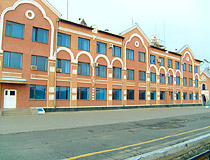
Blagoveshchensk Railway Station
Author: Serj Kras
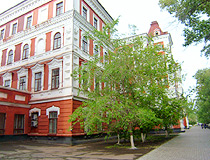
University in Blagoveshchensk
Author: Serj Kras
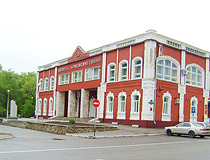
Wedding Palace in Blagoveshchensk
Author: Serj Kras
Blagoveshchensk - Features
About 800 meters of the Amur River separate Russian Blagoveshchensk and Chinese Heihe. The capital of Amur Oblast is the only administrative center of Russia located on the very border of the country. There is a visa-free regime between Blagoveshchensk and Heihe.
Blagoveshchensk was built up like a Roman military camp: wide, straight streets were parallel and perpendicular to each other. Some originated from the Amur River, others from the Zeya River. The blocks were regular rectangles. This layout of the city is still preserved. Today, Blagoveshchensk stretches for 8 km along the Amur and 13 km along the Zeya.
This city is located on the same parallel with the southern part of Central Russia and Kyiv (Ukraine). Despite this, winters are longer and much colder here. Blagoveshchensk has the continental version of the temperate monsoon climate. Summers are hot with a significant amount of sunshine. Winters are cold, dry, with little snow. The average temperature in January is minus 21 degrees Celsius, in July - plus 22 degrees Celsius.
It is an important industrial and commercial center of the Russian Far East. There are several large industrial enterprises: Amur Metalworker (mining equipment), shipbuilding plant (sea tug boats and seiners), Zeya confectionery factory, Amur factory of reinforced concrete structures.
Public transport in Blagoveshchensk is represented by buses, minibuses, and taxis. In addition, ships (in winter - buses, in the off-season - hovercrafts) carry passengers across the Amur River. Air traffic passes through Ignatievo Airport, which has international status. There are regular flights to Moscow, Novosibirsk, Vladivostok, Yuzhno-Sakhalinsk.
Blagoveshchensk has a rich historical and cultural heritage. On the territory of the city there are more than 80 monuments of architecture and monumental art. There is a number of original wooden buildings of the 19th century.
Main Attractions of Blagoveshchensk
The Arc de Triomphe (Triumphal Arch) - one of the symbols of Blagoveshchensk recreated in accordance with archival documents in 2003-2005. The original arch, erected in honor of the visit of Prince Nicholas (future Emperor Nicholas II), was built in 1891. But it was damaged by flooding and dismantled in the 1930s. Krasnoflotskaya Street, 145, near Victory Square and the embankment of the Amur River.
On the embankment of the Amur River (along Krasnoflotskaya Street), you can also find several monuments reflecting the history of Blagoveshchensk: Monument to Frontier Guards near the Rotunda, Monument to the Armored Boat of Project 1125 (in honor of the crossing of the Amur River by the Soviet army during the Second World War), Monument to N.N. Muravyov-Amursky (founder of Blagoveshchensk). Walking along the embankment, you can also enjoy the views of the city of Heihe located on the other bank of the Amur River.
The Amur Regional Museum of Local Lore named after G. S. Novikov-Daursky - the oldest local history museum in the Russian Far East (founded in 1891) and one of the most important historical buildings of Blagoveshchensk. Among the exhibits presented in the museum there are unique costumes and belongings of Daurian and Evenki shamans, the Ust-Nyukzha meteorite, and bones of fossil animals. Lenina Street, 165.
The Amur Paleontological Museum. The exhibition presents unique finds from excavations made in the Amur region, where several unique paleontological objects are located, including the Blagoveshchensk dinosaur location. The museum houses the largest collection of dinosaurs in Russia. Relochnyy Pereulok, 4.
The Amur Drama Theater (1886) - the cultural center of Blagoveshchensk. The repertoire of the theater includes classical and contemporary plays. Lenina Street, 146.
The Fire Tower (1914) - an original structure resembling the contours of a medieval tower. Amurskaya Street, 72.
Lake of Lotuses in Ivanovka - a man-made lake located near a small village about 40 km east of Blagoveshchensk. A very rare plant is grown here - lotus Komarova (Nelumbo nucifera) listed in the Red Book of Russia. During the flowering period, the pond looks amazing. Not only botanists but also tourists from the Far Eastern and Siberian cities come here to see this beauty. Lotus blooms from the third decade of July to the third decade of August.



